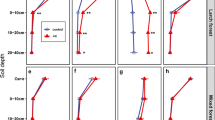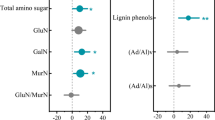Abstract
Nitrogen (N) resorption from senescing leaves enables plants to reuse N, thereby making them less dependent on current N uptake from the environment. Therefore, N resorption is important for survival and fitness, particularly for plants growing under low N supply. We studied N resorption from senescing leaves of 25 legumes and 25 nonlegumes in a temperate region of Japan to test the hypothesis that high N resorption has not evolved in legumes that fix atmospheric N2. The extent of N resorption was quantified by N resorption proficiency that is measured as the level to which leaf N concentration was reduced during senescence, i.e., the lower the senesced leaf N concentration, the lower the N loss through leaf fall and higher the N resorption proficiency. In support of the hypothesis, senesced leaf N concentration was higher in legumes than in nonlegumes, but there was considerable overlap between the groups. The higher senesced leaf N concentration of legumes was associated with a lower proportion of leaf N resorbed during senescence, particularly in species with higher leaf N concentrations. According to a hierarchical partitioning analysis, there was a large contribution of species to the total variance in the senesced leaf N concentration as opposed to a minor contribution of functional group (legume/nonlegume). This study reveals that legumes are not proficient at resorbing N from senescing leaves but that N2-fixation might not be the single most important determinant of N resorption.



Similar content being viewed by others
Notes
Recently, a new subfamilial classification of Fabaceae was proposed (Azani et al. 2017), but in this study, we adopt the traditional classification system in which the information on difference in nodulation status among subfamilies is well organized.
References
Adams MA, Turnbull TL, Sprent JI, Buchmann N (2016) Legume are different: leaf nitrogen, photosynthesis, and water use efficiency. Proc Natl Acad Sci USA 113:4098–4103
Aerts R (1996) Nutrient resorption from senescing leaves of perennials: are there general patterns? J Ecol 84:597–608
Aerts R, Chapin FS III (2000) The mineral nutrition of wild plants revisited: a re-evaluation of processes and patterns. Adv Ecol Res 30:1–67
Azani N, Babineau M, Bailey CD et al (2017) A new subfamily classification of the Leguminosae based on a taxonomically comprehensive phylogeny. Taxon 66:44–77
Chuyong GB, Newbery DM, Songwe NC (2000) Litter nutrients and retranslocation in a central African rain forest dominated by ectomycorrhizal trees. New Phytol 148:493–510
de Faria SM, Lewis GP, Sprent JI, Sutherland JM (1989) Occurrence of nodulation in the Leguminosae. New Phytol 111:607–619
del Arco JM, Escudero A, Garrido MV (1991) Effects of site characteristics on nitrogen retranslocation from senescing leaves. Ecology 72:701–708
Doyle JJ (1998) Phylogenetic perspectives on nodulation: evolving views of plants and symbiotic bacteria. Trends Plant Sci 3:473–478
Doyle JJ, Luckow MA (2003) The rest of the iceberg. Legume diversity and evolution in a phylogenetic context. Plant Physiol 131:900–910
Drenovsky RE, Pietrasiak N, Short T (2019) Global temporal patterns in plant nutrient resorption plasticity. Glob Ecol Biogeogr 28:728–743
Felsenstein J (1985) Phylogenies and the comparative method. Am Nat 125:1–15
Finzi AC, Allen AS, DeLucia EH, Ellsworth DS, Schlesinger WH (2001) Forest litter production, chemistry, and decomposition following two years of free-air CO2 enrichment. Ecology 82:470–484
González-Zurdo P, Escudero A, Mediavilla S (2015) N resorption efficiency and proficiency in response to winter cold in three evergreen species. Plant Soil 394:87–98
Hayes P, Turner BL, Lambers H, Laliberté E (2014) Foliar nutrient concentrations and resorption efficiency in plants of contrasting nutrient-acquisition strategies along a 2-million-year dune chronosequence. J Ecol 102:396–410
Inagaki M, Kamo K, Miyamoto K, Titin J, Jamalung L, Lapongan J, Miura S (2011) Nitrogen and phosphorus retranslocation and N: P ratios of litterfall in three tropical plantations: luxurious N and efficient P use by Acacia mangium. Plant Soil 341:295–307
Killingbeck K (1996) Nutrients in senesced leaves: keys to the search for potential resorption and resorption proficiency. Ecology 77:1716–1727
Killingbeck K, Costigan SA (1988) Element resorption in a guild of understory shrub species: niche differentiation and resorption thresholds. Oikos 53:366–374
Killingbeck K, Whiford W (2001) Nutrient resorption in shrubs growing by design, and by default in Chihuahuan Desert arroyos. Oecologia 128:351–359
Kobe RK, Lepczyk CA, Iyer M (2005) Resorption efficiency decreases with increasing green leaf nutrients in a global data set. Ecology 86:2780–2792
Lal CB, Annapurna C, Raghubanshi AS, Singh JS (2001) Effect of leaf habit and soil type on nutrient resorption and conservation in woody species of a dry tropical environment. Can J Bot 79:1066–1075
Li L, Li X, Liu B, Lei J, Yue Z, Li C (2020) Imbalanced stoichiometric patterns in foliar nutrient resorption response to N and P addition in grazing alpine grassland. Acta Oecol 102:103505
Liang D, Zhang J, Zhang S (2015) Patterns of nitrogen resorption in functional groups in a Tibetan alpine meadow. Folia Geobot 50:267–274
Norris MD, Reich PB (2009) Modest enhancement of nitrogen conservation via retranslocation in response to gradients in N supply and leaf N status. Plant Soil 316:193–204
Oikawa S, Ehara H, Koyama M, Hirose T, Hikosaka K, Chen CP, Nakamura H, Sakai H, Tokida T, Usui Y, Hasegawa T (2017) Nitrogen resorption in senescing leaf blades of rice exposed to free-air CO2 enrichment (FACE) under different N fertilization levels. Plant Soil 418:231–240
R Core Team (2019) R: a language and environment for statistical computing. R Foundation for Statistical Computing, Vienna
Ratnam J, Sankaran M, Hanan NP, Grant RC, Zmbatis N (2008) Nutrient resorption patterns of plant functional groups in a tropical savanna: variation and functional significance. Oecologia 157:141–151
Rejmánková E (2005) Nutrient resorption in wetland macrophytes: comparison across several regions of different nutrient status. New Phytol 167:471–482
Sprent JI (2001) Nodulation in legumes. The Royal Botanic Gardens, Kew
Stewart JR, Kennedy GJ, Landers RD, Dawson JO (2008) Foliar-nitrogen and phosphorus resorption patterns differ among nitrogen-fixing and nonfixing temperate-deciduous trees and shrubs. Int J Plant Sci 169:495–502
van Heerwaarden LM, Toet S, Aerts R (2003a) Current measures of nutrient resorption efficiency lead to a substantial underestimation of real resorption efficiency: facts and solutions. Oikos 101:664–669
van Heerwaarden LM, Toet S, Aerts R (2003b) Nitrogen and phosphorus resorption efficiency and proficiency in six sub-arctic bog species after 4 years of nitrogen fertilization. J Ecol 91:1060–1070
Vergutz L, Manzoni S, Porporato A, Novais RF, Jackson RB (2012) Global resorption efficiencies and concentrations of carbon and nutrients in leaves of terrestrial plants. Ecol Monogr 82:205–220
Walsh C, Mac Nally R (2013) Package ‘hier.part’. https://cran.r-project.org/web/packages/hier.part/index.html
Waterman PG (1994) Costs and benefits of secondary metabolites to the Leguminosae. In: Sprent JI, McKey D (eds) Advances in legume systematics 5: the nitrogen factor. Royal Botanic Gardens, Kew, pp 129–149
Yonekura K, Kajita T (2003) BG plant index (Y-List, https://ylist.info)
Yuan ZY, Chen HYH (2009) Global trends in senesced-leaf nitrogen and phosphorus. Glob Ecol Biogeogr 18:532–542
Yuan ZY, Li LH, Han XG, Huang JH, Jiang GM, Wan SQ, Zhang WH, Chen QS (2005) Nitrogen resorption from senescing leaves in 28 plant species in a semi-arid region of northern China. J Arid Environ 63:191–202
Zhao G, Shi P, Wu J, Xiong D, Zong N, Zhang X (2017) Foliar nutrient resorption patterns of four functional plants along a precipitation gradient on the Tibetan Changtang Plateau. Ecol Evol 7:7201–7212
Acknowledgments
We thank Yasuo Yamamura, Yasuhiko Endo, Kouki Hikosaka and four anonymous reviewers for comments. Thanks are also extended to Keisuke Toyama, Masayuki Negami and other staff members of The University of Tokyo, Chiba Forest. Ogawa branch of Hitachi-Omiya City Office supported the fieldwork.
Funding
Support for this work was provided by Nippon Life Insurance Foundation and JSPS KAKENHI Grant Number 17K07554 to SO.
Author information
Authors and Affiliations
Contributions
SO designed the research. SO, YM, RT, TT, and AT conducted field works. Laboratory works was carried out by SO, YM, RT and TT. SO, MOG, MOK and TI analyzed the data and drafted the manuscript.
Corresponding author
Ethics declarations
Conflict of interest
None declared.
Additional information
Publisher's Note
Springer Nature remains neutral with regard to jurisdictional claims in published maps and institutional affiliations.
Electronic supplementary material
Below is the link to the electronic supplementary material.
Rights and permissions
About this article
Cite this article
Oikawa, S., Matsui, Y., Oguro, M. et al. Species-specific nitrogen resorption proficiency in legumes and nonlegumes. J Plant Res 133, 639–648 (2020). https://doi.org/10.1007/s10265-020-01211-1
Received:
Accepted:
Published:
Issue Date:
DOI: https://doi.org/10.1007/s10265-020-01211-1




